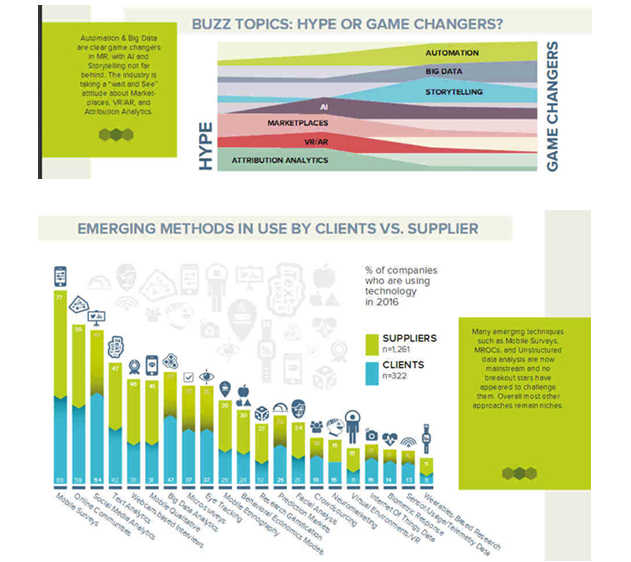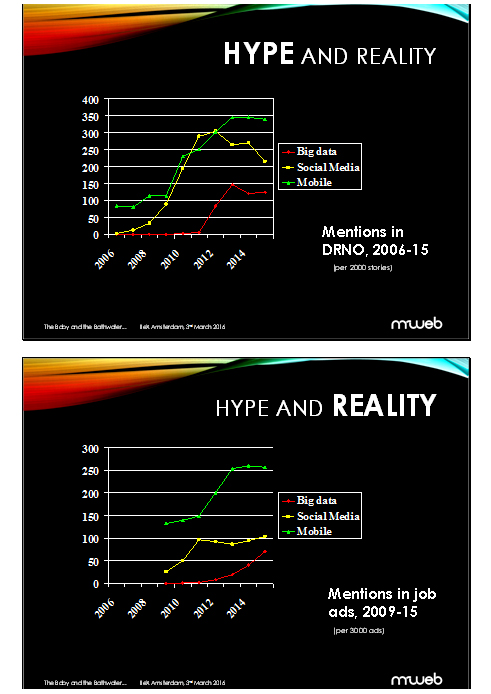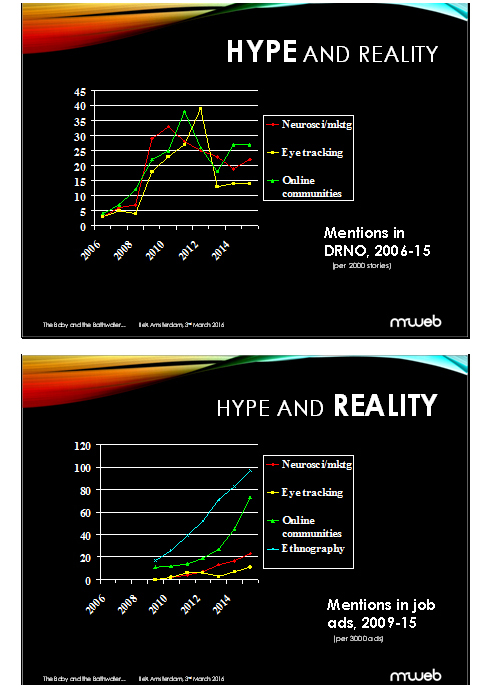Hype and Reality: the impact of various new technologies
As might be expected, or apparent from the above, market researchers do 'hype' rather well, such that it's difficult to tell which of the much-talked-about new technologies and techniques are making a real impact on the day-to-day lives of research professionals. The GRIT Report, published each quarter for many years now by our US partner firm GreenBook, is based on responses from researchers worldwide - just under 1,600 of them in the Q1 2017 wave - and sets out to establish which trends are happening, how widely they're affecting current practice and what respondents see as the next big things. As GreenBook itself says in the preface, the sample is not representative of the industry and by its nature it's bound to attract some of the more forward-thinking and leading edge in the profession, but it does provide very interesting comparisons and pointers in terms of emerging trends.
This issue notes that automation of research processes is having a big effect on current MR, as is big data. AI - artificial intelligence - is not far behind, although the term covers a huge range of technologies from simple trial-and-error machine learning to very sophisticated programmes, and a lot of the latter potential is still in the hype category. Interestingly 'Marketplaces' - online buy-and-sell type exchanges for information - are still seen as having little impact, 'though we at MrWeb see them as one to watch closely.

A question on methods already in use shows the huge impact of mobile surveys, used now by the great majority of providers and most clients, while majorities also make use of online communities, social media and (other) text analytics. Big data is not far behind, although interestingly clients are more likely to be using it than providers offering it, suggesting that this is an area where users are often going to non-MR-type companies (here software providers, we imagine). Note that the figures show the proportion of companies or individuals making *any* use of the technique / technology in the last year - they do not say how much.
Further down the list are some interesting rankings. Behavioural economics and facial analysis are two areas where larger MR groups have been making big investments and announcing tech partnerships of late, but they have still to be adopted by the majority even of GRIT's relatively leading edge participants; while neuroscience is perhaps the most obviously over-hyped technology area of the last ten years. Practitioners have been claiming for a while now that the ability to track emotional response directly via EEG or fMRI, for example, would quickly render 'traditional MR' redundant, but in eight years or so thus far it's established itself as a useful and substantial niche rather than a mould-breaker.
Analysis of our postings shows some similar results (...and corroboration of findings from two entirely independent sources always brings a big smile to the face of a good researcher…). Looking at mentions of technologies in DRNO news articles gives us a picture of what's being announced and promoted - very much the leading edge - while looking at what skills are being sought in job ads tells us more about money being put where mouth is, and is therefore more of an indicator of current activity. The following figures only go up to January 2016 but broadly reflect what we see today.

All three technology areas appear to have reached something of a peak in terms of announcements, and social media analysis has if anything dropped slightly, having perhaps entered a new phase in what Gartner would call its 'Hype Cycle'. It's also fairly flat in terms of job ad mentions, suggesting that research firms have realised it's a useful tool in the toolbox and they must have some staff who can build it into surveys, but equally that they don't see it as the answer to everything – whereas mobile might just be, and continues to dominate innovation in the industry. As for big data, the second chart may answer the old question about whether it's ever going to realise its potential to revolutionise research, and justify the hype – it shows a smooth and steep upward curve in job ad requirements.

Neuroscience techniques and eyetracking (the latter used to see which parts of pages and screens draw people's attention for how long, etc..) have established themselves as useful activities in some types of research, but in terms of skills requirements lag far behind experience with online communities, a fast growing area in job ads. Here's an interesting one: ethnography, that is studying human behaviour close-up, in its natural environment, has featured in steadily more job ads since 2009 and maintains it lead over the other three on this chart. By the way it gets very few news mentions, hence no coverage on the top chart. Perhaps we should be hunting down more stories about it?
Read about Neighbouring sectors, or go on to the Size and structure of the industry.
About the industry - contents...
1. What is MR and how is it changing?
A comprehensive guide to what we do, how it's changing, and who else does similar stuff.
2. The global industry today
The supply side: revenues, rankings and company info, full listings.
3. Careers in MR
An introduction to the career ladder, activities, salaries and choices.